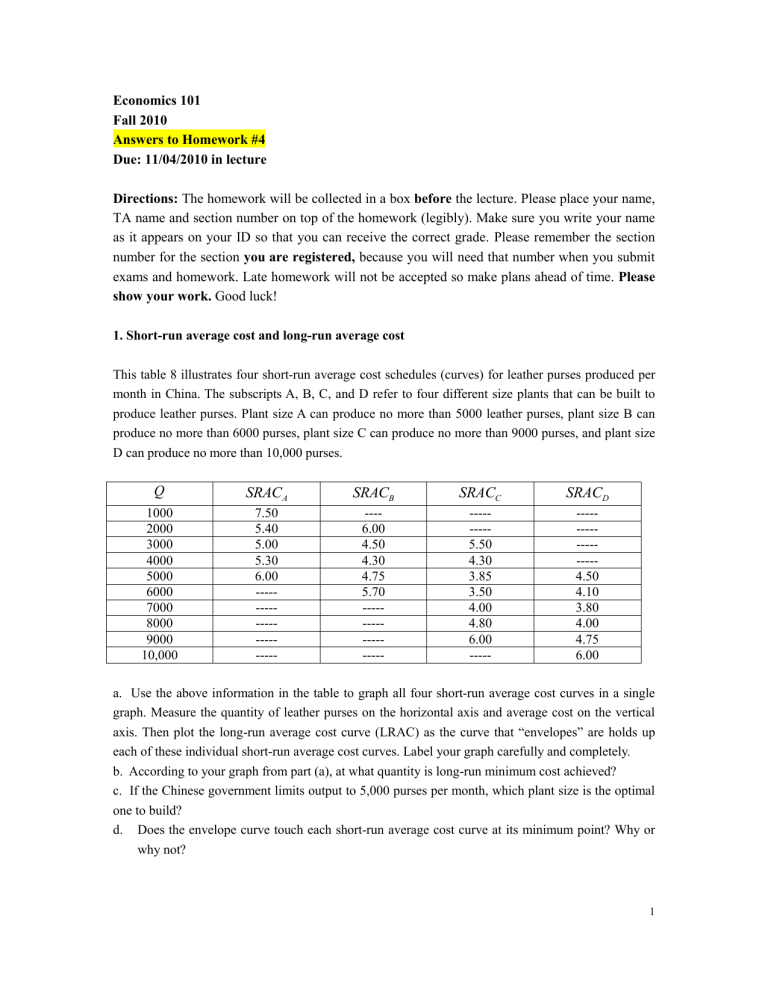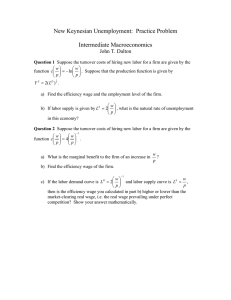Economics 101 Fall 2010 Answers to Homework #4 Due: 11/04/2010 in lecture

Economics 101
Fall 2010
Answers to Homework #4
Due: 11/04/2010 in lecture
Directions: The homework will be collected in a box before the lecture. Please place your name,
TA name and section number on top of the homework (legibly). Make sure you write your name as it appears on your ID so that you can receive the correct grade. Please remember the section number for the section you are registered, because you will need that number when you submit exams and homework. Late homework will not be accepted so make plans ahead of time. Please show your work. Good luck!
1. Short-run average cost and long-run average cost
This table 8 illustrates four short-run average cost schedules (curves) for leather purses produced per month in China. The subscripts A, B, C, and D refer to four different size plants that can be built to produce leather purses. Plant size A can produce no more than 5000 leather purses, plant size B can produce no more than 6000 purses, plant size C can produce no more than 9000 purses, and plant size
D can produce no more than 10,000 purses.
Q
1000
2000
3000
4000
5000
6000
7000
8000
9000
10,000
SRAC
A
7.50
5.40
5.00
5.30
6.00
-----
-----
-----
-----
-----
SRAC
B
----
6.00
4.50
4.30
4.75
5.70
-----
-----
-----
-----
SRAC
-----
-----
5.50
4.30
3.85
3.50
4.00
4.80
6.00
-----
C
SRAC
-----
-----
-----
-----
4.50
4.10
3.80
4.00
4.75
6.00
D a. Use the above information in the table to graph all four short-run average cost curves in a single graph. Measure the quantity of leather purses on the horizontal axis and average cost on the vertical axis. Then plot the long-run average cost curve (LRAC) as the curve that “envelopes” are holds up each of these individual short-run average cost curves. Label your graph carefully and completely. b. According to your graph from part (a), at what quantity is long-run minimum cost achieved? c. If the Chinese government limits output to 5,000 purses per month, which plant size is the optimal one to build? d.
Does the envelope curve touch each short-run average cost curve at its minimum point? Why or why not?
1
Answer: a. b. 6,000 units. c. SRAC
C d. No;. It touches the short-run curves before their minimum point when the envelope curve (long-run average cost curve) is downward sloping, and touches the short-run curve past their minimum point when the envelope curve is upward sloping.
2
2. a. The following tables give information about costs for a firm. Complete the two tables:
Table A
Q Total Cost Fixed Cost
0 $3,500 $3,500
1 $5,000 $3,500
Variable
Cost
$1,500
Marginal
Cost
2
3
4
$5,650
$6,050
$6,250
$3,500
$3,500
$3,500
$2,550
$650
Total
Average
Cost
Fixed
Average
Cost
$875
Variable
Average
Cost
5
6
$6,800
$8,050
7 $11,150
8 $17,500
$3,500
$3,500
$3,500
$3,500 $2,188
$1,093
9 $27,500 $3,500
Table B
4
5
6
7
Q Total Cost Fixed Cost
0 $0 $0
Variable
Cost
1
2
$1,550
$2,900
$0
3 $4,170 $4,170
Marginal
Cost
$5,440
$6,750
$8,050
$9,449
$1,300
Total
Average
Cost
$1,360
Fixed
Average
Cost
Variable
Average
Cost
$1,450
8 $10,880
9 $12,510
$0 b. Which table, A or B, represents firm’s short run situation, and which represents firm’s long run situation? How do you know? c. At what output level would the firm’s short run and long run average costs be the same?
3
Answer:
1)
SHORT RUN
Q Total Cost
0 $3,500
Fixed
Cost
$3,500
1
2
3
$5,000
$5,650
$6,050
$3,500
$3,500
$3,500
4
5
$6,250 $3,500
$6,800 $3,500
6 $8,050 $3,500
7 $11,150 $3,500
Variable
Cost
$0
$1,500
$2,150
$2,550
$2,750
$3,300
$4,550
$7,650
8 $17,500 $3,500 $14,000
9 $27,500 $3,500 $24,000
Marginal
Cost
$0
$1,500
$650
$400
$200
$550
$1,250
$3,100
$6,350
$10,000
Total
Average
Cost
-.-
$5,000
$2,825
$2,017
$1,563
$1,360
$1,342
$1,593
$2,188
$3,056
Fixed
Average
Cost
-.-
$3,500
$1,750
$1,167
$875
$700
$583
$500
$438
$389
Variable
Average
Cost
-.-
$1,500
$1,075
$850
$688
$660
$758
$1,093
$1,750
$2,667
Q Total Cost
0 $0
1
2
3
4
$1,550
$2,900
$4,170
$5,440
5
6
$6,750
$8,050
7 $9,449
8 $10,880
9 $12,510
Fixed
Cost
$0
$0
$0
$0
$0
Variable
Cost
$0
$1,550
$2,900
$4,170
$5,440
$0
$0
$6,750
$8,050
$0 $9,449
$0 $10,880
$0 $12,510
LONG RUN
Marginal
Cost
$0
$1,550
$1,350
$1,270
$1,270
$1,310
$1,300
$1,399
$1,431
$1,630
Total
Average
Cost
-.-
$1,550
$1,450
$1,390
$1,360
$1,350
$1,342
$1,350
$1,360
$1,390
2) In the long run there are no fixed costs, all inputs are variable. Therefore, Table B represents the long run.
Fixed
Average
Cost
-.-
$0
$0
$0
$0
$0
$0
$0
$0
$0
Variable
Average
Cost
-.-
$1,550
$1,450
$1,390
$1,360
$1,350
$1,342
$1,350
$1,360
$1,390
3) At 6 units. See that at this point long run total average cost and short run average cost are equal.
4
3.
Nominal and Real Prices
Jack, Paul, and Robin graduated from UW-Madison in the spring of 2007 and they have worked in
Tokyo, Paris, and Madison respectively Jack’s monthly wage in 2007 was 100 (measured in hundred dollars-that means that his monthly wage was $100,000); Paul’s monthly wage in 2007 was 60 (again, measured in hundred dollars); and Robin’s monthly wage in 2007 was 96 (hundred dollars).
In 2008,
Jack’s nominal wage increased by 4% and Paul’s nominal wage decreased by 10% while Robin experienced no change in his nominal wage. Between 2007 and 2008 inflation rates were 30% for
Tokyo, -28% for Paris, and 20% for Madison. (Assume that year 2007 is the base year for the CPI for
Tokyo, Paris, and Madison) a. Complete the following table based on the information you were given and assuming that 2007 is the base year.
Jack in Tokyo
Nominal wage in 2007 100
Nominal wage in 2008
CPI 2007
CPI 2008
Real wage in 2007
Real wage in 2008
Paul in Paris
60
Robin in Madison
96
Nominal wage in 2007
Nominal wage in 2008
CPI 2007
CPI 2008
Real wage in 2007
Real wage in 2008
Jack in Tokyo
100
104
Paul in Paris
60
54
100
130
100
72
(100/100)*100=100 (60/100)*100=60
(104/130)*100=80 (54/72)*100=75
Robin in Madison
96
96
100
120
(96/100)*100=96
(96/120)*100=80 b. Did any of these three individuals experience an increase in their nominal wage and a decrease in their real wage?
Jack’s nominal wage increased by 4 but his real wage decreased by 20. c. Did any of these three individuals experience a decrease in their nominal wage and an increase in
5
their real wage?
Paul’s nominal wage decreased by 6 but his real wage increased by 15. d. At the beginning of 2009, Paul was offered a raise to 81 for his position in Paris. But Paul decided to accept a job offer from a company in Madison. Working in Madison, Paul earned the nominal wage of 150 in 2009. Between 2008 and 2009, inflation rates were the same in Paris and Madison and
Paul’s real wage in 2009 turned out to be 100. What would Paul’s real wage had been in 2009 had he stayed in Paris and earned a nominal wage of 81? You might find it helpful to organize your thinking by using the following table.
Year Nominal Real Wage
Wage in
Paris in Paris
2007
2008
2009
CPI in Paris Nominal
Wage in
Madison
-----
----
Real Wage in Madison
-----
----
CPI in
Madison
100
Answer:
Year Real Wage in Madison
CPI in
Madison
2007
2008
2009
Nominal
Wage in
Paris
60
54
81
Real Wage in Paris
60
75
90
CPI in Paris Nominal
Wage in
Madison
100
72
90
-----
-----
150
-----
-----
100
100
120
150
Because 100
150
CPI
2010
Madison
100 tells that CPI
2010
Madison
150 , the inflation rate was
30
120
100
25% . Since Paris and Madison had the same inflation rate,
CPI
2010
Paris
72 (1 0.25)
90 . Had Paul stayed in Paris and earned the nominal wage of 81, his
81 real wage would have been
90
100
90
6
4. Elasticity and Total Revenue
Guam and Hawaii initially both operate as closed economies, which means that they had consumed only domestically produced goods. Madison Coke Company (MCC) made an agreement with the government of Guam and Hawaii respectively to exclusively provide coke to the market in these two economies. Before opening the branches and providing soda to the market, MCC conducted a consumer survey and found out that the demand curve for soda was P=20-2Q in Hawaii and P=40-5Q in Guam. a. Initially MCC provided coke to each island at the price of 5 dollars. Last month MCC increased the price to $20 in both islands. Calculate the price elasticity of demand for each island using the standard percentage method (that is, calculate the price elasticity of demand using the standard percentage formula and not the arc elasticity formula). Calculate the total revenue from each island at the price of
$20.
Answer:
When the price is $5, the quantity demanded in Guam is 7 units of coke and the quantity demanded in
Hawaii is 7.5 units. When the price is $20, the quantity demanded in Guam is 4 units and the quantity demanded in Hawaii is 0 units.
Guam
7
5 20
5
1
7
Hawaii
7.5
5 20
5
1
3
TR
Guam
TR
Hawaii
20 4 80
20 0 0 b. Calculate the price elasticity of demand for each island using the mid-point method. Compare your result using the mid-point (or arc elasticity method) to the result from part (a) using the standard method.
Answer:(Note: this is a correction to what was initially posted!)
7
Price elasticity of demand for Guam = absolute value of {[(4 – 7)/(7 + 4)]/[(5 – 20)/(5 + 20)]} = 5/11
Price elasticity of demand for Hawaii = absolute value of {[(0 – 7.5)/(7.5 + 0)]/[(5 – 20)/(20 + 5)]} =
5/3 c. Calculate the price elasticity of demand for Guam and Hawaii at the price of $10 using the point elasticity formula. Calculate the total revenue from each market at this price.
Q P
P Q
1 P slope Q
Hawaii
1 10
2 5
1
Guam
1 10
1
5 6 3
TR
Hawaii
TR
Guam
10 5 50
10 6 60 d. Find the price level that maximizes the total revenue from the coke market in Guam. Find the price level that maximizes the total revenue from the coke market in Hawaii. What is the sum of the total revenue from both islands if MCC prices coke in each market to maximize its revenue (i.e., MCC can charge different prices in the two markets)?
First we note that where the point elasticity equals one, the revenue is maximized.
From c. we have seen that at p Guam =10 the market demand of Guam has unit elasticity and the maximized revenue from Guam is TR
Guam
10 5 50
To find the price level for Hawaii where the price elasticity equals to one, we note that when the demand curve is straight line, the point of unit elasticity lies in the middle of demand curve. Therefore, the demand curve of Hawaii, P =40-5Q tells us that the price level that maximizes the revenue from
Hawaii is P Hawaii =20. (or from
Hawaii
1 P
5 Q
5
Q
1 , we have Q=4 and P=20.) The
Q corresponding revenue from Hawaii at P Hawaii =20 is TR
Hawaii
20 4 80
Therefore, MCC maximizes its total revenue by charging $10 for coke in Guam and $20 for coke in
8
Hawaii.MCC earns total revenue of $50 + $80 = $130.
5. Income and Substitution Effects
John loves eating blueberries (B) and almonds (A). During winter, the price of a pound of blueberries is $4 and the price of a pound of almonds is $2. John has an income of $60 in the winter to spend on blueberries and almonds. a. With blueberries on the x-axis and almonds on the y-axis, draw John’s winter budget line (BL winter ) and translate your drawn line into an equation for John’s winter budget line.
4 B
2 A
60 b. Suppose that the optimal consumption bundle (A,B) satisfies
MU ( , )
B
MU ( , )
A
A B
2
A
B
. Under
BL winter , find the optimal consumption bundle and draw an indifference curve (IC winter ) passing through it.
We know that John maximizes their satisfaction or utility when the slope of the indifference curve is equal to the slope of the budget line or, in absolute value terms, when
MU
B
P
B
. Since
MU
A
P
A
MU
B
MU
A
A
2 B
and
P
B
P
A
4
this tells us that 4
2
A
B . With this information and the budget line we can solve for B and A: B = 5 and A = 20. c. During summer, the price of a pound of blueberries is $1 and the price of a pound of almonds is $2.
Suppose John has an income of $60. With almonds on the y-axis and blueberries on the x-axis, draw
John’s budget line (BL summer ) and translate this information into an equation for John’s summer budget line.
B
2 A
60 d. Find the optimal consumption bundle with John’s summer budget line and draw an indifference curve (IC summer ) passing through it.
9
We know that John maximizes his satisfaction when the slope of the indifference curve is equal to the slope of his budget line, or, in absolute value terms, when
MU
B
P
B
. Since
MU
A
P
A
MU
B
MU
A
A
2 B
and
P
B
P
A
1
this tells us that B A
2
. With this information and John’s budget line we can solve for B and A: B = 20 and A = 20. e. Now in your graph shift John’s summer budget line to the left until it becomes tangent to John’s winter indifference curve (IC winter ). (You are now drawing a budget line that can be labeled “budget line 3”: this new budget line should be parallel to John’s summer budget line and just tangent to the indifference curve representing John’s utility or satisfaction in the winter.) You are told that this new point of tangency corresponds to approximately 12.6 pounds of blueberries and 12.6 pounds of almonds. Calculate the substitution effect and income effects for blueberries as the price of blueberries decreases from $4 a pound to $1 a pound. During summer, what is the income level that John would need to have in order for him to have the same utility level as he had during winter?
Substitution effect=12.6-5=7.6 pounds of blueberries
Income effect=20-12.6=7.4 pounds of blueberries
John needs $1 12.6 $2 12.6
$37.8
during summer to have the same utility level he enjoyed during winter.
A
20
12.6
W
IC summer
Z
S
IC winter
5 12.6 20
BL summer
B
10
BL winter
BL summer shifted to the left
11





